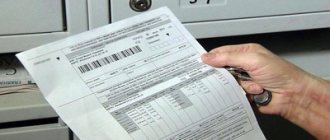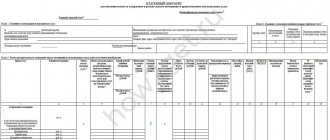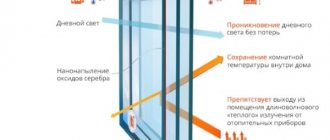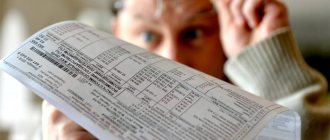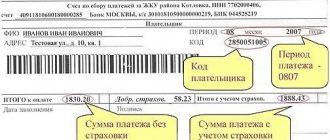Balance is a term adopted in economic theory. It involves certain calculations. Used in foreign trade relations, within the framework of accounting. Necessary for tracking the dynamics of the company's activities. Allows you to reflect the success of the organization. The balance is determined based on accounting information.
Question: How, when terminating a leasing agreement at the initiative of the lessor, are the balance of counter obligations calculated and the determination of which party to the agreement bears the final obligation? View answer
The meaning of the term "balance"
A similar column may appear for any payment, including electricity, gas, cold or hot water and others. This standard accounting term comes to us from the Italian language and denotes the difference between the fee paid by the consumer and the amount of paid services or resources.
It is used not only in utility payments, but also in any type of settlement, including international and domestic trade, balance of payments and other areas of activity.
It is possible to display the following balance on the receipt:
- negative – indicates an overpayment for this type of resource;
- positive – warns about the presence of debt on the corresponding position.
A zero balance means that the owner has fully paid for the services provided, without any debt or exceeding the required amount. In this case, its size will coincide with the amount payable at the end of the current month.
This value is indicated in a separate column, indicating the date to which it is given.
It can be determined:
- at the beginning of the reporting month - will be called incoming,
- at the end of the reporting month or other period - outgoing.
What it is
The word balance came into Russian from Italy (sounds like saldo), where it means calculation, remainder. In the 19th century, merchants and people who kept barn books began to use the word “balance” to denote the difference between receipts and expenditures, mainly money, for a certain period of time: month, quarter, year. Almost immediately it began to be used by academic economists in works on the theory of economics to describe the movement of funds. After this, balance became a mandatory accounting term, showing the total amount in monetary terms for each account.
Let us recall that accounting is a system of accounts where the property of the organization keeping records is recorded at the beginning of the reporting period, its movement and sources of formation (in this case, a separate account is opened for each accounting object). At the end of the period, the results of the work are summed up: the amount at the beginning of accounting and at the end is compared. If at the end of the period the account balance is positive - more has arrived than it has lost, then the balance is positive. If it’s the other way around, then it’s negative.
Thanks to the balance, the owner (manager) of an enterprise or organization can obtain the following data:
- availability of fixed assets in monetary terms minus their depreciation. Let me explain. Buildings, machines and equipment are working. Consequently, their initial cost decreases. This reduction is called depreciation. Subtracting the accrued amount of depreciation expenses from the cost of fixed assets at the beginning of the reporting period, we obtain the cost minus depreciation, i.e. current real value;
- the cost of raw materials, auxiliary materials, fuels and lubricants, spare parts, equipment, workwear and containers that are in the warehouse (raw materials and materials transferred to production, but not yet used, are not taken into account here);
- balance of funds in ruble and foreign currency bank accounts;
- the amount of debt owed by buyers for products shipped without prepayment or work (services) performed;
- debt to counterparties (buyers) who paid for the goods in full or in part, but did not receive it by the end of the reporting period;
- value of other assets.
After filling out the accounts, the organization’s balance sheet is formed, consisting of two parts:
- passive – right side. Shows debt to counterparties;
- the asset is the left side. All funds owned by a company or organization are shown here.
At the same time, there is a nuance that is difficult for people without special education to understand: on the left side, the receipt of funds is shown as a debit (we owe), the disposal is shown as a credit (we owe), but on the right it’s the other way around. Income is considered a credit, outflow is considered a debit (you can read more on the topic here).
Debit balance, do we owe it or are we owed? On the active side of the balance sheet (active accounts), we are owed. On the passive side, on the contrary, we must.
Example
To understand what a balance is in accounting, let's give an example for dummies. To derive the balance, the cash flow in the current account is taken. The numbers and the entries themselves are conditional (in real accounting, entries are written completely differently, but the meaning is the same).
| Debit | Credit | ||
| Balance at the beginning of the month (initial) | 1 350 211,25 | ||
| Consumption (raw materials paid) | 516 321,00 | ||
| Receipt (funds received for sold products) | 4 890 000,00 | ||
| Expense (loan repaid to bank) | 1 000 000,00 | ||
| Expense (salaries paid) | 3 569 741,90 | ||
| Expense (taxes paid) | 583 578,09 | ||
| Turnover by debit | 4 890 000,00 | Loan turnover | 5 669 640,99 |
| Balance at the end of the month (final) | 570, 570,26 |
Note that if the balance does not converge, then the balance for each account is reconciled.
Reasons for appearance
The formation of a positive or negative balance may be due to the following circumstances:
- If there is a debt for any of the resources used or services provided, its cost is added to the current payment for the month, with the need for full repayment.
- If money is not deposited on time, the amount may not be taken into account during the invoice generation process. The receipt indicates the date before which the consumer must make final payment. If the funds are not deposited on time, with a high degree of probability the positive balance in the receipt will increase due to the formation of a debt.
- If the owner does not promptly submit information about the actual readings of individual metering devices to the utility organization. If the company does not have accurate data, average values are indicated in the invoice, which may differ from the actual values in one direction or another, with the formation of an appropriate balance.
- An error may occur during banking transactions, as a result of which the money does not reach the addressee.
Depending on the rules established by utility organizations in a particular region, information on meter readings must be provided between the 23rd and 26th of the current month. Otherwise, there may be discrepancies in the issued receipt.
Primary symptoms of intoxication
To prevent castor beans from harming the body, you need to be able to correctly and timely identify poisoning by them.
Often, the development of intoxication with this poison of plant origin occurs within 15-20 hours. If ricin enters the bloodstream through the respiratory system, the process may begin earlier. An immediate reaction of the body can be observed only if the patient has an allergy.
You should be wary of the following symptoms:
- intestinal colic;
- burning sensation on mucous membranes, including inside the body;
- nausea with vomiting;
- loose stools with bloody impurities.
A little later, more severe symptoms are added to the listed signs:
- convulsions,
- cyanosis,
- pressure drop,
- feeling of prostration.
But even with such signs, not everyone is in a hurry to go to the hospital. If you delay this, the patient will inevitably die. It occurs due to severe damage to the liver and spleen. The stomach and intestines are also affected, subject to constant hemorrhages. The clinical picture ends with renal dystrophy. Castor beans also have an effect on the pancreas.
During hospitalization and diagnostics, red blood cells are detected in the patient’s urine. The analysis will also show the presence of hemoglobin, protein and casts in the urine. And upon examination of the lymph nodes in the abdominal cavity, abnormalities typical for intoxication will be detected.
How to avoid balances
To avoid deviations in calculated payments and payments made, consumers of utility services need to be disciplined and attentive when making payments to resource suppliers. This requires:
- Report in a timely manner, in the prescribed manner, the actual readings of individual metering devices.
- No later than the date indicated on the receipt, pay the invoices received, paying the amount exactly as indicated in the document, taking into account the presence of debt or overpayment.
- Correctly calculate the amount of payments if the amount to be paid is determined independently.
- Please indicate your payment details accurately to avoid the possibility of sending money to the wrong account.
We recommend: Procedure for replacing an electricity meter
If payment is made on time and accurately, there is no need to fear that the amount paid will differ from the actual cost of the resources consumed.
It is necessary to keep receipts of payments made to prove the fact of payment in the event of disputes. There may be technical failures during banking operations or errors by utility company personnel, as a result of which paid funds are not accounted for properly. If there is appropriate documentary evidence, the misunderstanding can be resolved.
To avoid possible problems, owners need to regularly contact resource and service providers to recalculate the current amount. In this case, it will be possible to timely identify the fact of deviation from the required payment amount in one direction or another and understand the reasons for its occurrence.
The balance column in the utility payment receipt allows the owner to accurately represent the current picture regarding payment for housing and communal services in order to prevent the occurrence of debts or overpayments.
Application in accounting
Balances on all accounts as of December 31 of the reporting year are needed to generate the enterprise’s annual financial statements (balance sheet and applications). Debit balances are included in the balance sheet assets, credit balances are included in liabilities. For external users (for example, to obtain a loan from a bank), it is necessary to draw up an operating balance using the balances as of the specified date.
The term "balance" is also used in macroeconomics.
In the trade balance
Shows the value of a country's exports and imports over a specified period (usually a year). The active part reflects the export of goods produced or processed in the country. Passive - import of goods for domestic consumption or processing.
The trade balance is the difference between exports and imports. Positive when exports exceed imports and negative when imports exceed exports.
The trade balance is part of the balance of payments.
In the balance of payments
All foreign economic transactions of the country are reflected. Shows the ratio of payments made abroad and received in the country. The balance of payments is compiled using the double entry principle. The credit shows transactions that bring currency into the country (recorded with a “+” sign), the debit shows transactions that result in the consumption of currency (reflected with a “-“ sign).
The balance of payments consists of 4 sections:
- current account;
- movement of capital;
- foreign exchange reserves;
- errors and omissions.
Section 1 consists of the trade balance and balances of services, net investment income, and current transfers.
The balance is calculated as the difference between the current account and capital account balances. Positive when foreign exchange receipts exceed expenses (surplus) and negative when foreign exchange expenses exceed earnings (deficit). Covered by changes in foreign exchange reserves.
In international trade
The indicators of foreign trade of different countries are taken into account. They are calculated based on balance of payments data and characterize the country's solvency and its capabilities in international trade.
The result indicators are the balance:
- trade and payments balance;
- balance of services;
- balance of goods and services;
- current account.
Responsibility for unpaid balance
Failure to pay the accumulated balance may result in the following warnings and penalties:
- Accrual of penalties - penalties depend on a certain percentage of the rate of the Central Bank of the Russian Federation, which can change and be accrued every day. The amount to be paid depends on the number of days after which payment was received. When paying a debt for a period of 31 to 90 days, the penalty will be 1/300 of the Central Bank key rate, after 91 days 1/130 of the Central Bank rate.
- After a certain excess of the balance and payment deadline, the consumer may have the service disconnected for non-payment. They will connect only after all debts and fines have been paid.
What is the balance in utility bills 2021 - in the housing and communal services receipt
In payment documents for utility bills there are several different columns that explain what exactly the payment is for. However, not everyone understands what the balance in utility bills is in 2020.
Payment for housing and communal services
To avoid possible conflicts with government agencies, citizens need to know how and where they can pay money for the use of public services. For each service, tariffs are set by the executive authority, the energy commission and the local administration.
The latter, in turn, should not go beyond the current Russian legislation. Based on these documents, payment is collected from persons evading this payment.
At this point in time, there are several different ways to pay for housing and communal services. The main ones are:
- postal or bank office;
- ATMs;
- payment terminals;
- electronic resources.
What is a balance in utility bills?
Having wondered what the balance in utility bills is and what it means, you need to know that this term is most often used in accounting. The word originally appeared in this industry back in the 19th century.
Then it meant a certain amount of finance remaining in account balances. In the modern world, the term balance extends to large sectors of activity.
At this point in time, accounting specialists note with these indicators the state of the financial security of a company in relation to a certain date.
This term shows the difference between funds received and spent on company accounts. Those. we can more simply say that the term balance denotes the difference between the income and expenses of a particular organization.
To calculate this indicator, specialists use a special document - a balance sheet, which records all transactions performed during the estimated period of time.
Indication of a numerical value in the balance column on a payment receipt may mean the following:
- the consumer has a monetary debt to the company supplying electricity;
- the citizen paid excess funds when making a previous payment;
- instrument readings for the previous reporting period were not taken into account; in this case, energy suppliers will calculate the payment amount based on average monthly electricity consumption indicators.
The amount will not be taken into account towards the payment for this reporting period if the citizen contributed funds to pay for this payment after the payment document was generated.
Provided that a person pays the amount for consumed electricity as an overpayment, but does not include it in the receipt, the person is recommended to independently take it into account when calculating the next payment. However, for this you will need to have official confirmation of the fact of making the payment.
Video about housing and communal services receipts
Attention!
- Due to frequent changes in legislation, information sometimes becomes outdated faster than we can update it on the website.
- All cases are very individual and depend on many factors. Basic information does not guarantee a solution to your specific problems.
That's why FREE expert consultants work for you around the clock!
APPLICATIONS AND CALLS ARE ACCEPTED 24/7 and 7 days a week.
Services for maintaining residential premises in an apartment building
- in the winter months, monitoring the removal of snow from citizens, clearing sidewalks and access roads from it, combating ice and ice on the intra-block territory;
- in the summer months, carrying out all necessary lawn care procedures;
- repair and maintenance of technical devices, household rooms, general communication systems, structural elements (this also includes all activities related to the heating systems of the house);
- 24/7 support for apartment residents in case of unforeseen emergencies;
- carrying out technical work to keep systems that are responsible for water supply (hot/cold), sewerage, electricity and heat supply up to date;
- all types of necessary actions in the event of emergencies, etc.
- monitoring property in common ownership through regular monitoring, testing and diagnostics of a technical nature, inspections and observations (technical devices, rooms for household purposes, general communication systems, structural elements located within the living area);
- seasonal preparation of an apartment building, ensuring the possibility of operating public property in all weather conditions (entrances, fences and front gardens, technical devices, household rooms, general communication systems). At the same time, they are guided by compliance with the norms and instructions of housing inspection employees, fire regulations, state energy supervision, sanitary and epidemiological stations with compliance with points, regulatory documents on technical support and equipment of a residential building in 2019;
- instant resolution of emergency situations, elimination of incidents that led to malfunction and inability to use the common property of a residential building. Immediate restoration of the life support system and violations of safety rules, repair of structures that threaten the health and life of owners and users of common living space;
- carrying out activities aimed at sanitizing and repairing property belonging to an apartment building on a general basis (adjacent land, attic, caring for trees, bushes, flowers, entrance, non-residential basement).
08 Aug 2021 piterurist
191
Classification and types of indicator
In accordance with the dynamics of movement in the account and the ratio of debit and credit, there are 2 types of balances:
- Debit is the state of the current account in which the amount of debt obligations to the organization exceeds the debt of the company itself. This indicator characterizes the dynamics of the enterprise’s assets over a certain period of time;
- Credit is a current account characterized by a company’s high debt and low obligations of its counterparties. This indicator is used to analyze the dynamics of the company's liabilities.
A surplus occurs when the cost of funds received by an enterprise exceeds its costs.
A low level of value of funds received and high expenses are interpreted as a passive balance.
The dynamics of balance changes is determined by the following concepts:
- initial balance – balance at the initial reference point. It reflects the result of movement on the account for the previous reporting period of time;
- the final (outgoing) balance is the result of operating results at the end of the reporting period. The indicator provides information about the state of the current account.
The balance for a certain period is the result of operations for a specific time sample.
Crisis 2021: news and forecasts for Russia. Where to invest and how to save money. Renting a home or having a mortgage? What to choose? Let's count togetherHow to store money with almost no riskWhere to invest money
